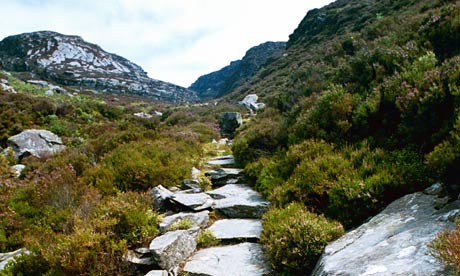Springy mesh may be easier on the feet, but I would take issue with bringing in any material that is not naturally indigenous to the area. I was up in Snowdonia at the weekend and noted they have been using plastic coated wire gabions to reinforce paths and create barriers to stop short cuts. Looks ok from a distance but hideous close up.
It's not new of course, the Romans were at it too.. Guardian (2011) Rhinogs - photo (Although I'd set out looking for some crazy Asian examples). Given the numbers in some areas there's no helping it, but it does seem strange in more remote locations.
The National Trust was it a few years ago calling these paths a wonderful achievement/improvement? Or was it Park authorities?

Last edited by LissaJous; 24-09-2014 at 09:10 AM.
Poacher turned game-keeper
Isn't the whole landscape we enjoy manufactured by humans anyways? Fells cleared of trees, stone walls, forestry, quarrying and mineworks give the whole place a certain unnatural look, of course no less beautiful... Whilst as runners we hate them stone slab paths, im of the opinion they are quite an apt addition to certain areas that are vulnerable to erosion
But the point is the distinction between footpaths created by the ingenuity of generations of walkers and runners and - by contrast - the artificiality of a stone slabbed footway. A natural footpath is often a thing of beauty as it wends its way up the mountainside, taking in clever little routes and meandering around obstacles, valleys etc.. A stone footway, on the other hand, has nothing to endear us to it. It is an ugly artificial imposition on the landscape, unpleasant both to look at and to run/walk on.
On the other hand,...
http://coolgeography.co.uk/GCSE/AQA/...20District.jpg
or even Os 001.jpg
(Soldier's Lump Summit, Black Hill Plateau, Holmfirth)
Last edited by Graham Breeze; 03-10-2014 at 10:38 PM.